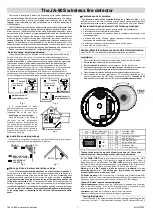
Subject to change without notice
6
General Information
This oscilloscope is easy to operate. The logical arrangement
of the controls allows anyone to quickly become familiar with
the operation of the instrument, however, experienced users
are also advised to read through these instructions so that all
functions are understood.
Immediately after unpacking, the instrument should be
checked for mechanical damage and loose parts in the interior.
If there is transport damage, the supplier must be informed
immediately. The instrument must then not be put into
operation.
Symbols
ATTENTION - refer to manual
Danger - High voltage
Protective ground (earth) terminal
Use of tilt handle
To view the screen from the best angle, there are three
different positions (C, D, E) for setting up the instrument. If
the instrument is set down on the floor after being carried,
the handle automatically remains in the upright carrying
position (A). In order to place the instrument onto a horizontal
surface, the handle should be turned to the upper side of the
oscilloscope (C). For the D position (10° inclination), the handle
should be turned to the opposite direction of the carrying
position until it locks in place automatically underneath the
instrument. For the E position (20° inclination), the handle
should be pulled to release it from the D position and swing
backwards until it locks once more. The handle may also be
set to a position for horizontal carrying by turning it to the
upper side to lock in the B position. At the same time, the
instrument must be lifted, because otherwise the handle will
snap back to the previous position.
Safety
This instrument has been designed and tested in accordance
with IEC Publication 1010-1 (overvoltage category II, pollution
degree 2), Safety requirements for electrical equipment for
measurement, control, and laboratory use. The CENELEC
regulations EN 61010-1 correspond to this standard. It has
left the factory in a safe condition. This instruction manual
contains important information and warnings which have to
be followed by the user to ensure safe operation and to retain
the oscilloscope in a safe condition.
The case, chassis and all measuring terminals are
connected to the protective earth contact of the
appliance inlet. The instrument operates according
to Safety Class I (three-conductor power cord with
protective earthing conductor and a plug with
earthing contact).
The main line plug shall only be inserted in a socket outlet
provided with a protective earth contact. The protective action
must not be negated by the use of an extension cord without
a protective conductor.
The main line plug must be inserted before connec-
tions are made to measuring circuits.
The grounded accessible metal parts (case, sockets, jacks)
and the main line supply contacts (line/live, neutral) of the
instrument have been tested against insulation breakdown
with 2200V DC.
Under certain conditions, 50Hz or 60Hz hum voltages can
occur in the measuring circuit due to the interconnection with
other main line powered equipment or instruments. This
can be avoided by using an isolation transformer (Safety Class
II) between the main line outlet and the power plug of the
device being investigated.
Most cathode-ray tubes develop X-rays.
However, the dose equivalent rate falls far below the
maximum permissible value of 36pA/kg (0.5mR/h).
Whenever it is likely that protection has been impaired, the
instrument shall be made inoperative and be secured against
any unintended operation. The protection is likely to be
impaired if, for example, the instrument
• shows visible damage,
• fails to perform the intended measurements,
• has been subjected to prolonged storage under unfavorable
conditions (e.g. in the open or in moist environments),
• has been subject to severe transport stress (e.g. do to
packaging).
Intended purpose and operating conditions
This instrument must be used only by qualified experts who
are aware of the risks of electrical measurement.
The instrument is specified for operation in industry, light
industry, commercial and residential environments.
Due to safety reasons the instrument must only be connected
to a properly installed power outlet, containing a protective
earth conductor. The protective earth connection must not
be broken. The power plug must be inserted in the power
outlet while any connection is made to the test device.
The instrument has been designed for indoor use. The
permissible ambient temperature range during operation is
+10°C (+50°F) ... +40°C (+104°F). It may occasionally be
subjected to temperatures b10°C (+50°F) and -10°C
(+14°F) without degrading its safety. The permissible ambient
temperature range for storage or transportation is -40°C (-
0°F) ... +70°C (+158°F). The maximum operating altitude is
up to 2200m (non-operating 15000m). The maximum relative
humidity is up to 80%.
If condensed water exists in the instrument it should be
acclimatized before switching on. In some cases (e.g.
extremely cold oscilloscope) two hours should be allowed
before the instrument is put into operation. The instrument
General Information






































